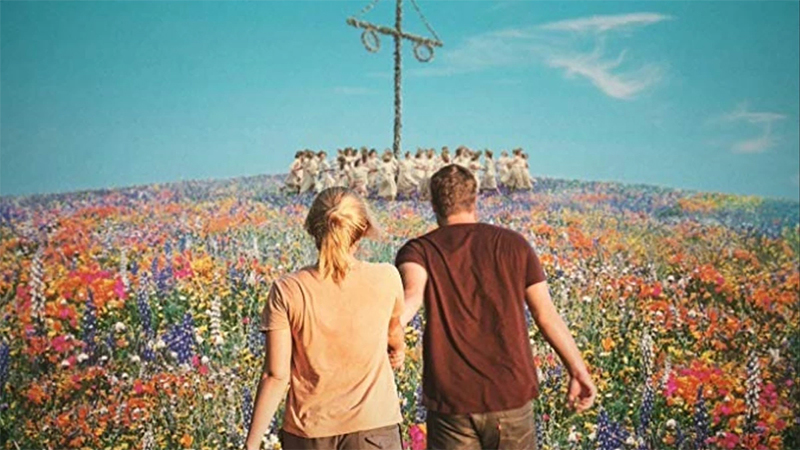Midsommar
Jul 13, 2019
Writing about Stanley Kubrick’s The Shining (1980), film critic Pauline Kael noted, ‘œIt took nerve, or maybe something more like hubris, for Kubrick to go against all convention and shoot most of this gothic in broad daylight. Probably he liked the idea of our waking into a nightmare instead of falling asleep into one.’ Kael meant it as a slam on Kubrick (whose films she rarely appreciated and usually found pretentious and misguided), although even his admirers can’t deny her point. It does take hubris to stage a film in a genre that so often relies on darkness in bright sunlight, which is precisely what Ari Aster does in his sophomore film Midsommar, which, while not as good of a film, still delivers on the promise he demonstrated in his horrifically and emotionally devastating debut Hereditary (2017). Aster carries through a number of themes and plot devices from Hereditary, including a devastating family tragedy as the catalyst for the horrors to come and the unsettling notion that you can’t trust or rely on those around you. Aster has described Midsommar‘”perhaps a bit tongue-in-cheek, but not really’”as a break-up movie, which is pretty much right on the mark since so much of its emotional register hinges on the protagonist’s dawning realization that her boyfriend isn’t really there for her.
The protagonist, Dani (Florence Pugh), is a college student who we first meet in the throes of another familial crisis involving her parents and her bipolar sister. In many ways, these opening scenes’”which are really prologue for what is to come’”are the film’s best, as Aster quickly and efficiently draws us into Dani’s incredibly stressed world of emails and text messages and phone calls, which she tries to alleviate by leaning on her boyfriend, an anthropology graduate student named Christian (Jack Reynor) who, unbeknownst to her, is on the cusp of breaking up with her because he doesn’t want to deal with her constant crises. Dani’s family situation turns tragic in the worst way imaginable, and the manner in which Aster reveals the extent of the tragedy would be simply perverse in its slow-burn aesthetic magnificence if it weren’t so emotionally effective. Aster is truly a master of suggesting the worst and drawing out the suspense before divulging it in a way that makes it actually worse than you feared.
Dani ends up joining Christian on a trip to Sweden with his friends and fellow graduate students Josh (William Jackson Harper), Mark (Will Poluter), and Pelle (Vilhelm Blomgren). Pelle is from a small, insular commune in the remote Swedish countryside, and his friends join him for what they expect will be a charming couple of weeks observing the commune’s annual celebration of the summer solstice’”flowers and dancing and food, oh my! And, at first, that is exactly what they get, as the commune appears to an eccentric, but peaceful outpost of collective ideals, and they live in an open swath of emerald-green-green space flanked by forest on either side. Everyone dresses in white, which makes the American interlopers with their multi-colored clothing stand out. Aster and cinematographer Pawel Pogorzelski (who also shot Hereditary) emphasize the beauty and the remoteness, with the intensity of the summer sun making the landscape into an almost impossible ideal of verdant fertility’”which is, of course, the perfect deception for the commune’s actual intentions, which are decidedly more insidious; the horrors, doled out in slow, but constantly escalating portions, arrive with placid smiles and a sense of disquieting calmness.
Those in the know will immediately recognize that Midsommar owes no small debt to Robin Hardy’s The Wicker Man (1973), a canonical British horror film that works a similar story involving a remote island community whose insidiousness is gradually revealed during the course of a police investigation. Midsommar suffers by comparison primarily because it lacks the element of surprise; we know going in that the commune is actually a haven of horrors, and the only real surprise is the exact nature of those horrors (which I will definitely not spoil here, except to say that the film gets cleverly grotesque and unsettling in its final third). The Wicker Man, on the other hand, had the benefit of misdirection via the investigation, which leads you to believe you’re watching a mystery instead of a horror film. That is why that film’s ending packed such a punch, while Midsommar‘s feels more logical’”horrible, but logical.
Even though Midsommar is not a Nordic film per se (that is, it is an American-funded and -produced film that happens to be set in a Nordic country), its characteristics are so similar to those of contemporary Nordic horror that one might imagine that Aster used Gunnar Iversen’s 2016 essay ‘œBetween Art and Genre: New Nordic Horror Cinema’ as a guide when writing the screenplay. According to Iversen, contemporary Nordic horror films frequently tell engaging stories that comment upon society, rely heavily on atmosphere, blend art cinema and genre horror, and combine Nordic traditional story elements in a transnational genre format, all of which aptly describe Midsommar. Most important, though, is the way Midsommar treats nature. Many Nordic horror films’”especially those made in Norway’”are set in the wilderness, which, according to Iversen, has long been traditionally viewed as ‘œa positive force, a site of leisure, contemplation, and regeneration’¦. Nature and the Norwegian landscape are seen as uplifting, democratic, and open spaces.’ However, recent horror films have reinvented that landscape into ‘œa space without boundaries in which anything can happen’”an amoral ground where danger, violence, and death loom large.’ And that is precisely what Aster achieves in Midsommar, using all that beautiful, illuminating daylight to draw us into an aesthetic appreciation of the landscape before revealing it to be a trap, a place so remote and self-contained that the worst can happen and no one would know.
Aster gets solid performances from his cast, particularly Florence Pugh, who like Toni Collette in Hereditary, is given the awful task of embodying grief as its most disabling and then working to pick up the pieces while her life is being undone by forces outside of her control. Some of the other characters feel a bit cardboard in comparison, including Jack Reynor’s Christian, who is alternately boring and irritating (which is, to some extent, evidence of his genuine lack of character), and Will Poulter’s Mark, who acts like a horndog imported from an ’80s animal comedy. Much of the humor is clearly intentional, and some of the best moments in Midsommar vacillate between horror and comedy in ways that some audiences will not know how to handle. The audience I saw it with found much of it humorous, but were clearly uncomfortable with their own laughing, particularly during a ritualistic sex scene that is simultaneously creepy and darkly hilarious’”Are we supposed to find this funny, or is there something wrong with us? Aster’s ability to get under the viewer’s skin is testament to his grasp of the genre and how it can work in so many different ways, and one can only wonder what nightmare he has for us to wake up into next.
Copyright © 2019 James Kendrick
Thoughts? E-mail James Kendrick
All images copyright © A24



